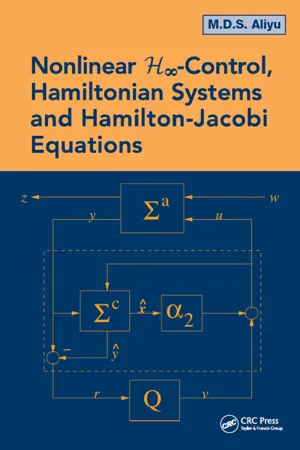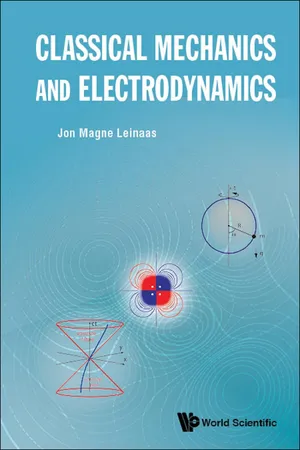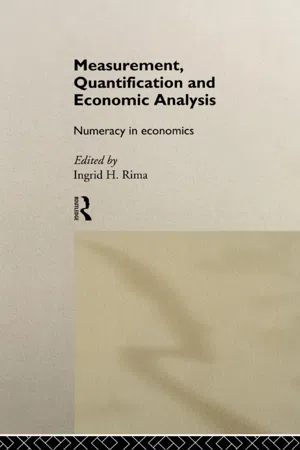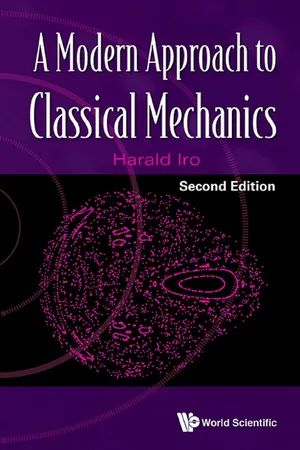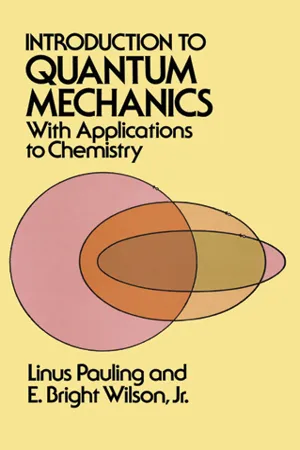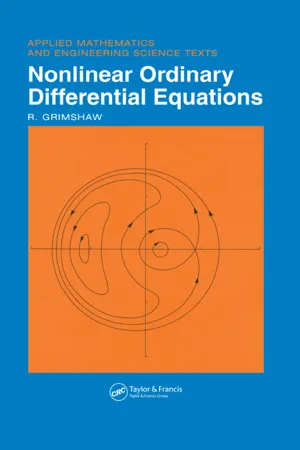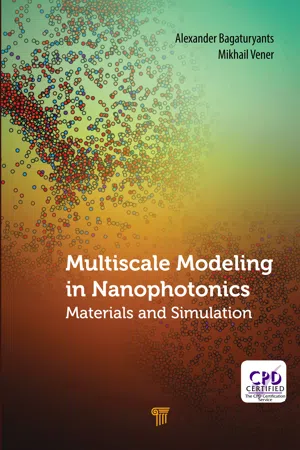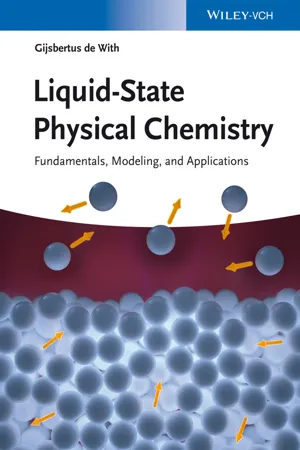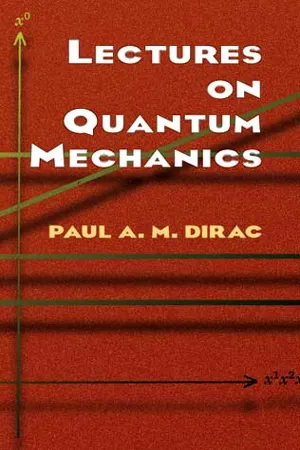Physics
Hamiltonian Mechanics
Hamiltonian mechanics is a formulation of classical mechanics that describes the evolution of a physical system over time. It is based on the concept of the Hamiltonian, which is a function that encapsulates the system's energy and dynamics. Unlike the more traditional Lagrangian mechanics, Hamiltonian mechanics emphasizes the use of generalized coordinates and momenta to describe the system's behavior.
Written by Perlego with AI-assistance
Related key terms
Related key terms
1 of 4
Related key terms
1 of 3
11 Key excerpts on "Hamiltonian Mechanics"
- eBook - ePub
Emergence of the Quantum from the Classical
Mathematical Aspects of Quantum Processes
- Maurice de Gosson(Author)
- 2017(Publication Date)
- WSPC (EUROPE)(Publisher)
Chapter 1
Hamiltonian Mechanics
Hamiltonian Mechanics is perhaps the most powerful classical theory ever; it allows the prediction of the motion of celestial bodies, of aeroplanes, and of particles in fluids. While Hamilton’s equations of motion are easily derived, in the simplest cases, from Newton’s second law, Hamiltonian Mechanics is more than just a fancy way of doing Newtonian mechanics. Hamiltonian Mechanics could already be found in disguise in the work of Lagrange in celestial mechanics. Namely, Lagrange discovered that the equations expressing the perturbation of elliptical planetary motion due to interactions could be written down as a simple system of partial differential equations (known today as Hamilton’s equations, but Hamilton was only six years old when Lagrange made his discovery!). It is however undoubtedly Hamilton who realized, some twenty four years later, the theoretical importance of Lagrange’s discovery and exploited it fully. We mention in passing that the notation H for a Hamiltonian function was proposed by Lagrange to honor Christiaan Huygens, and not Hamilton!Like the movement of a symphony, a Hamiltonian flow involves a total ordering which implies the whole movement: Past, present, and future are actively present in any one movement. When we are listening to music we are actually directly perceiving an implicate order. This order is active because it is continuously flowing in emotional responses which are inseparable from the flow itself. Similarly, the solutions of Hamilton’s equations are uniquely determined for all bounded times and all locations close to the original one, exactly as in the symphony metaphor: if we observe during a tiny time interval the motion of a particle moving under the influence of a Hamiltonian flow, we see an unfoldment of the totality of the flow, which is uniquely determined by the past — and the future! - M.D.S. Aliyu(Author)
- 2017(Publication Date)
- CRC Press(Publisher)
4 Hamiltonian Mechanics and Hamilton-Jacobi TheoryHamiltonian Mechanics is a transformation theory that is an off-shoot of Lagrangian mechanics. It concerns itself with a systematic search for coordinate transformations which exhibit specific advantages for certain types of problems, notably in celestial and quantum mechanics. As such, the Hamiltonian approach to the analysis of a dynamical system, as it stands, does not represent an overwhelming development over the Lagrangian method. One ends up with practically the same number of equations as the Lagrangian approach. However, the real advantage of this approach lies in the fact that the transformed equations of motion in terms of a new set of position and momentum variables are easily integrated for specific problems, and also the deeper insight it provides into the formal structure of mechanics. The equal status accorded to coordinates and momenta as independent variables provides a new representation and greater freedom in selecting more relevant coordinate systems for different types of problems.In this chapter, we study Lagrangian systems from the Hamiltonian standpoint. We shall consider natural mechanical systems for which the kinetic energy is a positive-definite quadratic form of the generalized velocities, and the Lagrangian function is the difference between the kinetic energy and the potential energy. Furthermore, as will be reviewed shortly, it will be shown that the Hamiltonian transformation of the equations of motion of a mechanical system always leads to the Hamilton-Jacobi equation (HJE) which is a first-order nonlinear PDE that must be solved in order to obtain the required transformation generating-function. It is therefore our aim in this chapter to give an overview of HJT with emphasis to the HJE.- eBook - ePub
- Jon Magne Leinaas(Author)
- 2018(Publication Date)
- WSPC(Publisher)
The Hamiltonian and Lagrangian formulations are generally more easy to apply to composite systems than the Newtonian formulation is. The main problem is to identify the physical degrees of freedom of the mechanical system, to choose a corresponding set of independent variables and to express the kinetic and potential energies in terms of these. The dynamical equations, or equations of motion, are then derived in a straight forward way as differential equations determined either by the Lagrangian or the Hamiltonian. Newtonian mechanics on the other hand expresses the dynamics as motion in three-dimensional space, and students who have struggled with the vector equations of a composite mechanical system know that such a vector analysis is not always simple. However, as is generally common when a higher level of abstraction is used, there is something to gain and something to lose. A well formulated abstract theory may introduce sharper tools for analyzing a physical system, but often at the expense of more intuitive physical interpretation. That is the case also for analytical mechanics, and the vector formulation of Newtonian mechanics is often indispensable for the physical interpretation of the theory.In the following we shall derive the basic equations of the Lagrangian and Hamiltonian Mechanics from Newtonian mechanics. In this derivation there are certain complications, like the distinction between virtual and physical displacements, but application of the derived formalism does not depend on these intermediate steps. The typical problem of using the Lagrangian or Hamiltonian formalism is based on a simple standardized algorithm with the following steps: First determine the degrees of freedom of the mechanical system and choose a set of independent coordinates, one for each degree of freedom. Next find the Lagrangian or Hamiltonian expressed in terms of the coordinates and their time derivatives and formulate the dynamics either as Lagrange’s or Hamilton’s equations. The final problem, which is the purely mathematical part, is then to solve the corresponding differential equations with the given initial conditions.Hamilton’s principle introduces a different view of the dynamics of Hamiltonian systems. The time evolution of the system is here expressed as solutions of a variational problem, rather than of a set of differential equations. The basic object in this description is the action, which is the time integral of the Lagrangian along paths which may be taken by the system. As will be shown, there is a simple relation between the two types of formulations, and this relation can be used to reformulate other types of variational problems in the form of differential equations. We illustrate this by some examples.Passage contains an image
Chapter 1
Generalized coordinates
1.1Physical constraints and independent variables
In the description of mechanical systems we often meet constraints, which means that the motion of one part of the system strictly follows the motion of another part. In the vector analysis of such a system there will be unknown forces associated with the constraints, and a part of the analysis of the system consists in eliminating the unknown forces by applying the constraint relations. One of the main simplifications of the Lagrangian and Hamiltonian formulations is that the dynamics is expressed in variables that from the beginning take these constraints into account. These independent variables are known as generalized coordinates - eBook - ePub
Measurement, Quantification and Economic Analysis
Numeracy in Economics
- Ingrid H. Rima(Author)
- 2002(Publication Date)
- Routledge(Publisher)
8 Hamilton mathematically simplified the solution of the problem of how to explain motion. He defined the auxiliary variable, momentumSince kinetic energy is the integral of Fx,Given (23.3), we can see that the Hamiltonian can be derived from the Lagrangian, and vice versa:Given the definition of potential energy,9the Hamiltonian could be rewritten asDifferentiating the Hamiltonian with respect to its two parts and setting each differential to zero gave two simultaneous first-order equations in two variables, known as the canonical equations, q gave the extreme value of H(x, ẋ,q) holding x constantand x gave the extreme value of H(x, ẋ,q) for fixed qwhich is equivalent to Newton’s second law.10 The physical system was stationary when q̇=ẋ=0. The system of first-order differential equations according to Hamilton achieved the goal of a “general solution of the general problem of dynamics” (Hamilton 1834:252).A more general energy conservation law applied to isolated systems when scientists took other forms of energy and energy transformations into account. Applying Hamilton’s principle, physicists found laws of reflection and refraction of light, and elementary phenomena of electricity, magnetism, heat and hydrodynamics. The program of energetics showed that events in different branches of physics satisfied one mathematical law and that conclusions arrived at in one field were to be reinterpreted for use in other fields (Wulwick 1987:217–18). Hamilton’s principle, “the pinnacle of mathematical physics”, played an essential part in consolidating nineteenth-century physics (Klein 1959:441).The energetics movement was not without opposition. Critics saw too many scientists ignoring the major purpose of the energetics analogy, i.e. to describe natural phenomena by a quantitative method based on the energy principle. According to the critics, the analogical method often produced research which embedded physics in a mechanical picture, which chiefly interested mathematicians. And scientists too often overlooked disanalogies. The dynamics of the Hamiltonian system were reversible; irreversible events characterized observed physical reality. Mathematicians could accept the closed system imposed by the Hamiltonian formalism; physicists should not (Jungnickel and McCormmach 1986:211–27). Proponents of energetics responded that it was useful to think of certain small systems (like a pendulum) as closed, as if no external forces acted on them and energy was conserved within them. The trick was convincingly to identify isolated systems.11 - eBook - ePub
- Harald Iro(Author)
- 2015(Publication Date)
- WSPC(Publisher)
13Hamiltonian Mechanics
In Lagrangian mechanics, the equations of motions are Lagrange’s equations for the action integral S (cf. Chapter 9 ). For the actual orbit, the action integral is extremal,Starting from this principle (see Section 9.3.4 ), W.R. Hamilton developed the most unified and elegant account of classical dynamics.Hamilton’s approach to classical mechanics was an essential prerequisite for the development of quantum mechanics – the theory of ‘atomic mechanics’ – that started to grow at the beginning of the 20th century.13.1 Hamilton’s equations of motion in phase space
The Lagrangian of a point mass with a single degree of freedom is a function of the independent variables q, , and t:Emphasizing the conjugate momentum (9.77) in view of its of its importance to the existence of conserved quantities, one could summarize Lagrangian theory by the equations:But this form is not particularly useful; one has only added a variable, namely p. Rather, it may be favorable to introduce q and p, instead of q and , as independent variables.This change is achieved by applying a Legendre transformation to the Lagrangian L. In this transformation, the derivative of the function in question (L) with respect to one of its arguments ( ) is introduced as new variable (p); in the process, a new function H(q, p, t) is constructed in place of L(q, , t). To find H, we use p = ∂L/∂ to rewrite the total (i.e. exact) differential of L,in the form Collecting the total differentials appearing on both sides, we obtaindH is the total differential of the function H = p − L (The sign is chosen by convention.). Eq. (13.2) shows that the independent variables1 are q, p, and t. Comparing Eq. (13.2) to total differential of H,yields the relationsThese three equations are in fact generally true for any two functions related by a Legendre transformation. The first and the last relations are typical for all variables not affected by the transformation (here, these are q and t; the sign results from the choice of sign for H). Conversely, the Lagrangian L is the Legendre transform of H, in which one switches from independent variables q and p to the independent variables q and . The second equation in (13.4) plays the same role as p = ∂L/∂ in the transformation from L to H - Linus Pauling, E. Bright Wilson, E. Bright Wilson(Authors)
- 2012(Publication Date)
- Dover Publications(Publisher)
Hamiltonian function .2b. The Hamiltonian Function and Equations. —For conservative systems1 we shall show that the function H is the total energy (kinetic plus potential) of the system, expressed in terms of thepk's andqk's. In order to have a definition which holds for more general systems, we introduce H by the relationAlthough this definition involves the velocities k , H may be made a function of the coordinates and momenta only, by eliminating the velocities through the use of Equation 2–5 . From the definition we obtain for the total differential of H the equationor, using the expressions forpkand k given in Equations 2–5 and 2–6 (equivalent to Lagrange's equations),whence, if H is regarded as a function of theqk's andpk's, we obtain the equationsThese are the equations of motion in the Hamiltonian or canonical form .2c. The Hamiltonian Function and the Energy. —Let us consider the time dependence of H for a conservative system. We haveusing the same substitutions forpkand k (Eqs. 2–5 and 2–6) as before. H is hence a constant of the motion, which is called the energy of the system. For Newtonian systems, in which we shall be chiefly interested, the Hamiltonian function is the sum of the kinetic energy and the potential energy,expressed as a function of the coordinates and momenta. This is proved by considering the expression for T for such systems. For any set of coordinates, T will be a homogeneous quadratic function of the velocitieswhere theHence so that 2d. A General Example.aij's may be functions of the coordinates.- eBook - ePub
- R. Grimshaw(Author)
- 2017(Publication Date)
- Routledge(Publisher)
CHAPTER ELEVEN HAMILTONIAN SYSTEMS 11.1 Hamiltonian and Lagrangian dynamicsA Hamiltonian system is one for which the equations can be obtained from a single scalar function, H(p, q, t), called the Hamiltonian, in terms of which the equations arep ′= −,∂ H∂ qq ′=.∂ H∂ p(1.1) In this chapter we shall follow the traditional custom for Hamiltonian systems that the dependent variables are denoted by p and q. Historically the interest in Hamiltonian systems is because frictionless, mechanical systems can be cast into the Hamiltonian form (1.1 ). In this context there is a beautiful and profound theory for Hamiltonian systems (see, for instance, Landau and Lifshitz, 1960, or Arnold, 1978). In general p and q are m-vectors, but here, in keeping with the general spirit of this text, we shall consider only the planar case when m = 1 and p and q are scalar variables. However, many, but not all, of the results that we shall describe have their counterparts for the general case.Before proceeding to discuss the system (1.1 ), we shall digress to show how a frictionless mechanical system can be cast into the Hamiltonian form. We have already given a brief account of this in section 6.4 for the autonomous case, and the more general non-autonomous case proceeds similarly. Thus, let q(t) represent the displacement at time t of a particle moving in a straight line subject to a potential-energy field U(q, t) per unit mass. Then the equation of motion isq ″+= 0.∂ U∂ q(1.2) To put this into the Hamiltonian form, let p = q′. Then (1.2 - eBook - ePub
- Robert Weinstock(Author)
- 2012(Publication Date)
- Dover Publications(Publisher)
lagrangian —as6-2. Hamilton’s Principle. Lagrange Equations of Motion(a ) Although Newton’s laws of motion are the most fundamental mathematical description of mechanical phenomena in general, it best suits the purposes of our study to assume the validity of Hamilton’s principle as the physical law which describes the motion of any system of the type considered in 6-1 above. The principle of Hamilton reads:The actual motion of a system whose lagrangian isis such as to render the (Hamilton’s) integralwhere t 1 and t 2 are two arbitrary instants of time , an extremum withrespect to continuously twice-differentiable functions q 1 (t ), q 2 (t ), …,qN(t )for which qi(t 1 )and qi(t 2 ) are prescribed for all i = 1, 2, …, N . We accept Hamilton’s principle as applicable to the motion of any conservative system.Although it is in some places stated that Hamilton’s principle may be used to replace Newton’s laws of motion as the fundamental starting point for mechanical systems possessing a lagrangian, it should be realized that Newton’s laws are implicitly employed in the preceding paragraphs in at least two ways: (i) The definition of mass resides in Newton’s third law. (ii) In the tacit assumption that our system of coordinates is fixed relative to an inertial frame of reference, we make use of Newton’s first law, by means of which an inertial frame is defined.(b ) With the result (57 ) of 3-8(a ) we conclude from Hamilton’s principle that the generalized coordinates describing the motion of a system of particles must satisfy the set of Euler-Lagrange equationsThe equations (8 ), Lagrange’s equations of motion, constitute a set of N simultaneous second-order differential equations, whose solution yields the functions q 1 (t ), q 2 (t ), …,qN(t ). The 2N constants involved in the general solution of (8 ) are evaluated when the initial (t = 0, for example) values of all theqiand (i = 1, 2, …, N ) are given. Once the initial state of the system is thus prescribed, its future motion is described in detail by the functions obtained through the solution of (8 - eBook - ePub
Multiscale Modeling in Nanophotonics
Materials and Simulations
- Alexander Bagaturyants, Mikhail Vener(Authors)
- 2017(Publication Date)
- Jenny Stanford Publishing(Publisher)
The quantity in the parentheses is the total energy of the system. However as independent variables, we consider now coordinates and momenta rather than coordinates and velocities. The total energy considered as a function of coordinates and momenta is called the Hamiltonian function and is given asFrom the equation for its total differentialH( p , q )=∑ip iq ˙- L = T( p )+ V( q ).it immediately follows thatd H( p , q , t )=∑iq ˙dp i-∑ip ˙dqi,(2.55)=∂ H∂p i,q ˙i= -∂ H∂q i. .p ˙iThe system of Eq. 2.55 is a system of 2 × 3N = 6N differential equations of the first order with respect to time for 6N unknown functions qi, pi.. This is distinct from the Lagrangian (Newtonian) which is a system of 3N differential equations of the system second order with respect to time for 3N unknown functions qi(ri) .2.4.1 Small Oscillations and Normal CoordinatesNow we consider one of the most important applications of classical mechanics for chemists. This is the problem of molecular vibrations. Another very important problem is molecular dynamics . Molecular dynamics will be considered in Chapter 4 , Section 4.3 . It is important here that both problems be treated within classical mechanics.Consider first the potential energy function V (qi) . Of our interest now is the case when this function has a minimum at some configuration. This means that,first all the partial derivatives of V (qq i=qi0i) equal zerofor all 1 ≤ i ≤ 3N and, second, the matrix of the second derivatives with respect to q= 0∂ V ( q )∂q ii(the so‐called Hessian matrix) is positive definite (for strict definitions) see Refs. [2 , 3 Such a configuration is an equilibrium point of the system because all forces vanish at this point. If the system assumes this configuration and all its velocities are zero, this means that it is at rest in this configuration.Let us assume now that the particles in our system move in the vicinity of this configuration, so the amplitude of motion is sufficiently small. Then, the potential energy function can be expanded in a Taylor series, and retaining the first nonvanishing term of the second order yields - eBook - ePub
Liquid-State Physical Chemistry
Fundamentals, Modeling, and Applications
- Gijsbertus de With(Author)
- 2013(Publication Date)
- Wiley-VCH(Publisher)
(2.50) . For the equations of motion we thus obtain(2.66)which are known as Hamilton's equations of motion and, because of their symmetry and simplicity, also are often called the canonical equations of motion. In this way the system is described by 6N first-order equations instead of the 3N second-order equations. The motion of set of particles can thus be described by a trajectory in a 6N-dimensional space, the so-called phase space, with coordinates q and p. The phase space is an essential concept in statistical mechanics.Formally, for a change of the Hamilton function with time t, we haveUsing Hamilton's equations it is easy to show that the first two terms cancel so that(2.67)Thus, a Hamilton function explicitly independent on time (but only implicitly via p and q) is constant, that is, where E is that constant. To interpret this constant for systems described by a Lagrange function , we consider and obtain(2.68)This result shows that the constant E equals the already defined energy but now expressed in terms of position and momentum as independent coordinates. As noted before, for a system with a time-independent potential, the energy and thus the Hamilton function is explicitly independent of time and the system is conservative. Finally, since is a function of q and p, we must express T also in terms of p. Inverting , we obtain . Hence(2.69)The Hamilton function thus reads . Note that the generalized force Q = AT f is not equal to . This is only true if M is independent of q, which generally is not the case.Example 2.5: The harmonic oscillator once moreWe treat once more the oscillator with kinetic energy T = ½mv2 = p2 /2m and potential energy Φ = ½kx2 . From Hamilton's equation , we get right away , resulting in the solution indicated in Example 2.3 . From Hamilton's we have the identity - eBook - ePub
- Paul A. M. Dirac(Author)
- 2013(Publication Date)
- Dover Publications(Publisher)
Of course, this work is to be considered as a preliminary piece of work. The final conclusion of this piece of work must be to set up an accurate quantum theory, and that involves quite serious difficulties, difficulties of a fundamental character which people have been worrying over for quite a number of years. Some people are so much impressed by the difficulties of passing over from Hamiltonian classical mechanics to quantum mechanics that they think that maybe the whole method of working from Hamiltonian classical theory is a bad method. Particularly in the last few years people have been trying to set up alternative methods for getting quantum field theories. They have made quite considerable progress on these lines. They have obtained a number of conditions which have to be satisfied. Still I feel that these alternative methods, although they go quite a long way towards accounting for experimental results, will not lead to a final solution to the problem. I feel that there will always be something missing from them which we can only get by working from a Hamiltonian, or maybe from some generalization of the concept of a Hamiltonian. So I take the point of view that the Hamiltonian is really very important for quantum theory.In fact, without using Hamiltonian methods one cannot solve some of the simplest problems in quantum theory, for example the problem of getting the Balmer formula for hydrogen, which was the very beginning of quantum mechanics. A Hamiltonian comes in therefore in very elementary ways and it seems to me that it is really quite essential to work from a Hamiltonian; so I want to talk to you about how far one can develop Hamiltonian methods.I would like to begin in an elementary way and I take as my starting point an action principle. That is to say, I assume that there is an action integral which depends on the motion, such that, when one varies the motion, and puts down the conditions for the action integral to be stationary, one gets the equations of motion. The method of starting from an action principle has the one great advantage, that one can easily make the theory conform to the principle of relativity. We need our atomic theory to conform to relativity because in general we are dealing with particles moving with high velocities.
Index pages curate the most relevant extracts from our library of academic textbooks. They’ve been created using an in-house natural language model (NLM), each adding context and meaning to key research topics.
Explore more topic indexes
Explore more topic indexes
1 of 6
Explore more topic indexes
1 of 4

